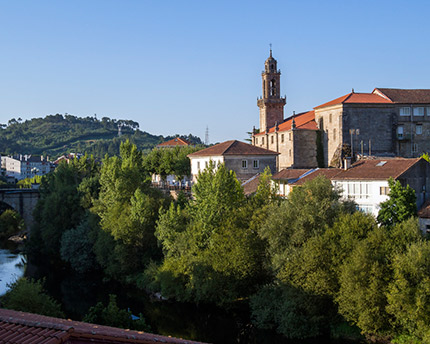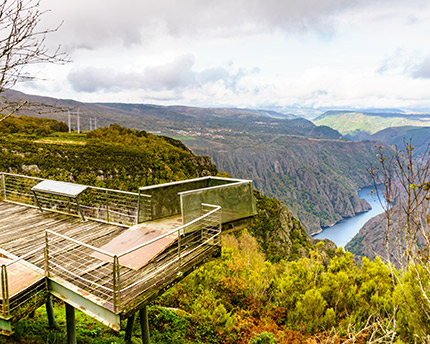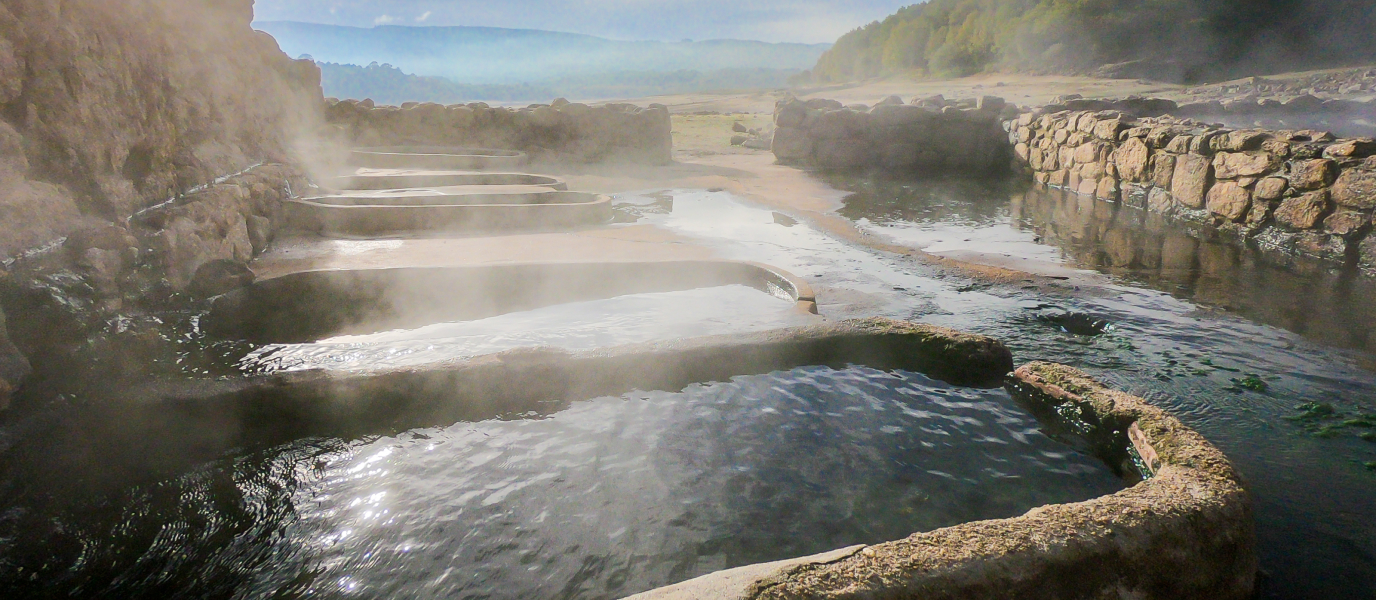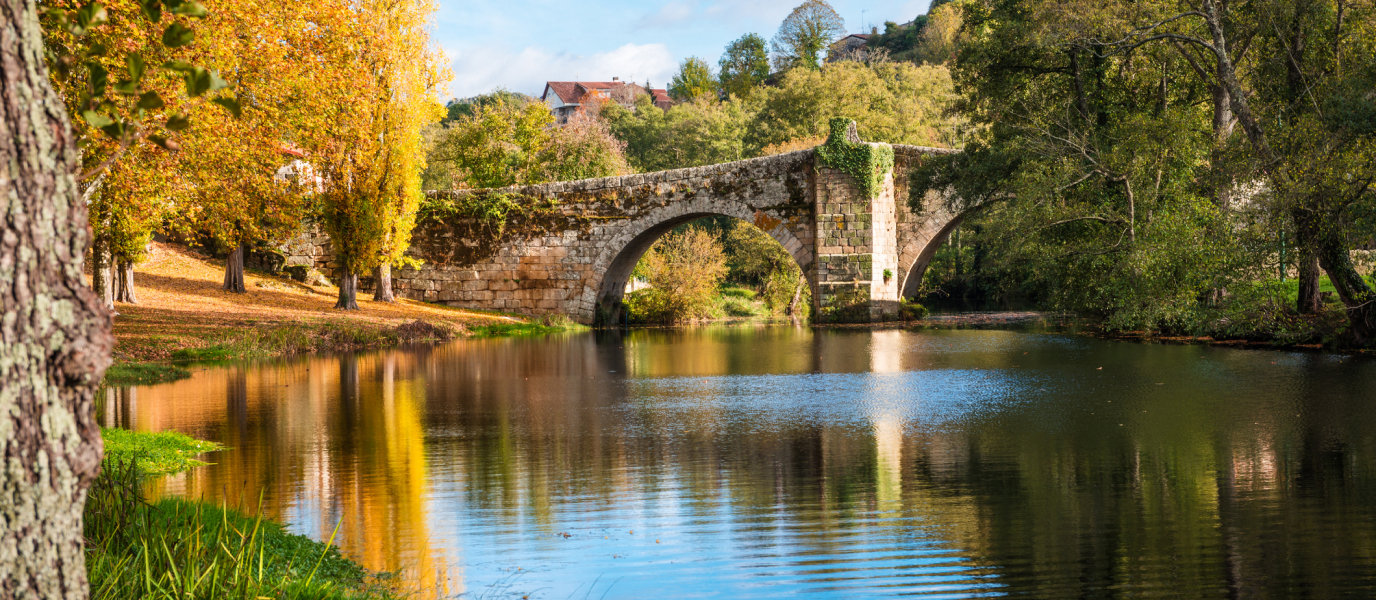Located just at the point where the river Avia flows into the river Miño, Ribadavia is, first and foremost, the capital of the Ribeiro wine-producing region. It is also a paradise for wine tourism and gastronomy, as well as a genuine historical and cultural treasure. In any event, this picturesque destination is one of the main attractions of the Province of Ourense and of course, well worth a visit.
The origins of Ribadavia are lost in the mists of time, but the town blossomed during the Middle Ages, and even became the capital of the kingdom of Galicia between 1065 and 1071. It was also the site of the most important Jewish settlement in the north-east of the Iberian peninsula. Of course, the vestiges of that time now form a vital part of the town’s extraordinary heritage, scattered throughout the historic quarter — declared an Asset of Cultural Interest in 1947 — and, of course, they provide the perfect excuse to visit it.
The Historic Quarter and the Plaza Mayor
Naturally, the nerve centre of Ribadavia is its historic quarter — and especially its ‘km 0’, the Plaza Mayor [Main Square]. This remarkable complex, dating back to medieval times, has been declared an Asset of Cultural Interest in the Monument of Artistic and Historical Interest category. Its principal edifice is the ‘pazo’ [mansion] of the Counts of Ribadavia, a great building in the Baroque style (seventeenth century), flanked by the Casa Consistorial [Town Hall] and its bell-tower (the former corn exchange dates from the seventeenth century, but has a Neo-classical façade), and other historic buildings from various periods.
Of course, the rest of Ribadavia’s historic quarter contains a much more extensive list of important buildings, starting with the Pazo de Baamonde, an eighteenth-century edifice which is now home to the interesting Ethnographic Museum; the church of Santiago, an outstanding example of the late twelfth-century popular Galician Romansque style; the Casa de la Inquisición, a sixteenth-century Gothic mansion which bears the coats-of-arms of the five local families linked to the Holy Office of the Inquisition… It could be said, however, that the most captivating feature of the medieval heart of Ribadavia is the maze of narrow streets, little squares, old stone houses, and magical corners that bear testament to the rich past of this part of Ourense.
Old Jewish Quarter
Beyond the shadow of a doubt, one of the most outstanding aspects of Ribadavia’s historical heritage is its old Jewish quarter, which entered a particularly auspicious period beginning in 1065, when King Don García made the town his capital. Later, the prosperity of the local population, both Jewish and Christian, was further boosted by the wine trade. Ribadavia’s Sephardic community continued to play a key role in the life of the town until the expulsion edicts of the late fifteenth century.
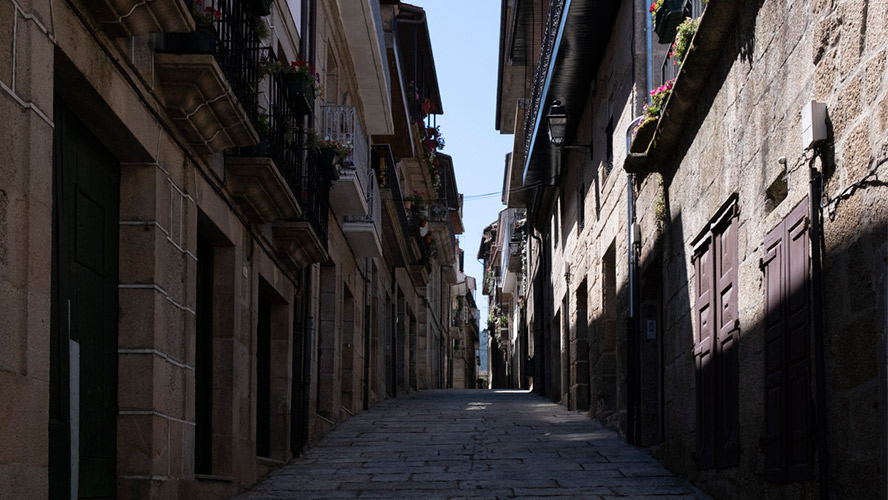
The best way of beginning to appreciate the Jewish legacy in this corner of the province of Ourense is by visiting the Galicia Jewish Information Centre, housed in the Pazo de los Condes de Ribadavia [Ribadavia Counts’ mansion], which offers a comprehensive and interesting insight into the history of Jewish communities throughout Galicia, both before and after 1492. Close by is the Jewish quarter itself, which stretched along the former Rúa Xudería (now Rúa Merelles Caula), from the Plaza Mayor to the medieval town wall, and from the Plaza de la Magdalena — where, apparently, the synagogue once stood — to Porta Nova. The maze of narrow streets, with their typical medieval layout, scattered with discreet symbols of Jewish culture, still recalls the times when the Sephardic Jews played a fundamental role in all kinds of towns and cities across the Iberian Peninsula.
Castle of the Counts of Sarmiento
Standing on a promontory at the far south of the historic quarter, this castle was one of Galicia’s most prominent fortresses, and the residence of the Condes de Ribadavia, the Sarmiento family from the second half of the fifteenth century until the seventeenth century — when they moved to what is known as the Palacio de los Condes [Counts’ Palace], their mansion in the Plaza Mayor.
Along with the remains of the castle itself (gateways, archways, walls, the parade ground, the ruins of towers, and so on), the castle complex also retains a unique necropolis with a dozen anthropomorphic tombs carved into the rock (ninth-twelfth centuries). These are linked to the chapel at San Xés, a pre-Roman treasure that occupied this site before the construction of the castle, and which was then transferred to the neighbouring parish of Francelos.
The place is also home to the Muestra Internacional de Teatro de Ribadavia, one of Galicia’s principal festivals of the performing arts, as well as of the famous Festa da Istoria, the great medieval festival (and one of the most authentic in Galicia), held annually at the end of August.
Convent of Santo Domingo
To the south-west of the castle, just at the point where the old wall ended, this collection of convent buildings founded in the thirteenth century has a Mendicant Gothic style, although the façade is Neo-classical. It was declared a National Monument in 1931. This was the second convent established by the Dominicans in Galicia, and is a true artistic and architectural jewel.
Inside, the church with its three great naves, arches, capitals, altarpieces, chapels, apses, carved stone coats-of-arms, windows and other architectural and decorative elements, provides a veritable treat for the senses. Also attached to the main complex is the chapel of the Virgen del Portal, the patron saint of Ribadavia and of the Comarca del Ribeiro. This is a remarkable building constructed between the seventeenth and nineteenth centuries. Inside, its outstanding feature is the Baroque altarpiece, dating from 1737, and carved from cypress wood.
Church of San Xoán
Back within the old town walls once again, we can see another of Ribadavia’s architectural treasures. This one is a gem constructed in the Romanesque style towards the end of the twelfth century and donated to the Order of Knights Hospitaller of Saint John of Jerusalem (also known as the Order of Malta, charged with protecting pilgrims along the Camino de Santiago). What is more, the same Order owned a convent and a hospital for pilgrims on one side of the church of San Xoán; an eight-pointed cross, the symbol of the Order, can still be seen above the door of the former rectory.
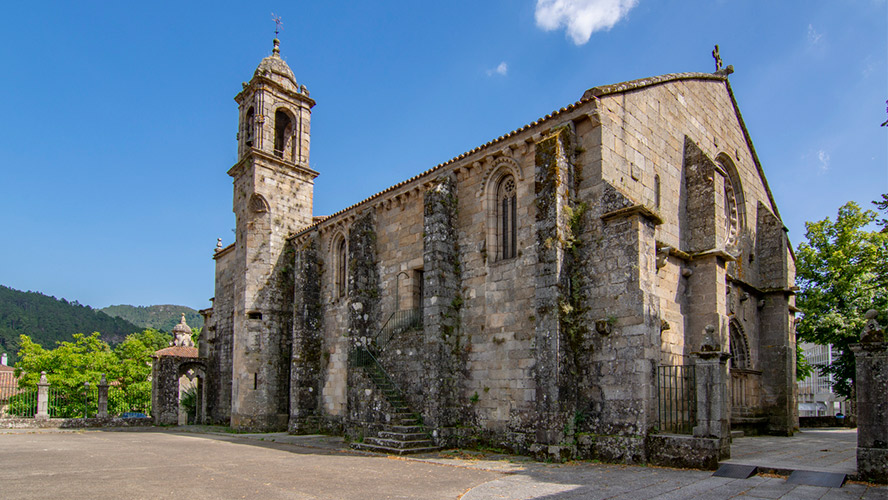
The small Romanesque church is noteworthy for the rich and varied decoration in the corbels, windows and doorways of its single nave, and inside the building in the half-barrel vault, the Baroque altarpiece dedicated to St Michael and the image of the Virgen de las Angustias. On the whole, this is a very well preserved building, especially considering that it is almost one thousand years old.
Ribadavia’s thermal springs
Por sus características geológicas, la provincia de Ourense es un paraíso del termalismo, y
The geological make-up of Ourense means that this province has an abundance of thermal springs, and Ribadavia is no exception. The temperature at which the springs gush forth from the ground and the therapeutic properties offered by their mineral content have been exploited since Roman times, or even earlier. It is no accident that the city of Ourense itself is known as the ‘City of Water’.
The Comarca del Ribeiro currently has five operational spa complexes, including the thermal baths of Berán, Cortegada, Arnoia Cladaria, and Laias Caldaria. The nearest spa complex to Ribadavia is the Termas de Prexigueiro. Located in the neighbouring parish of the same name, barely 10 minutes from the historic quarter and surrounded by woodland, these thermal springs have an outdoor thermal circuit of five hot-water pools and two cold-water pools, as well as a spa where visitors can enjoy hydromassage baths, vinotherapy, chocolate therapy, and seaweed treatments, along with other therapies.
Pozas de Melón
The area around Ribadavia also has all kinds of natural wonders, including this complex of natural swimming pools in the bed of the river Cerves, no more than 10 km from the historic quarter. The action of the water as its flows down the granite sides of the Sierra de Faro de Avión has carved out a genuine, natural spa, with all kinds of natural swimming pools and little waterfalls, which can be reached from the nearby village of Melón. The perfect spot in which to enjoy a refreshing bathe and relish the natural surroundings.
Moreover, a short distance upriver from the pools is the Fervenza de Tourón, a spectacular waterfall set among oak trees, yet another example of the area’s endless natural beauty. You can reach this spot by walking up from the pools along the paths that follow the course of the river, or along a path and over wooden walkways from the little village of Tourón, which is nearer to the waterfall itself.
Ribadavia’s wineries
Nature, culture, gastronomy, art, history… and exceptional wines; wine tourism is another of the indisputable attractions of Ribadavia. From touring the vineyards and terraces or ‘socalcos’, as they are known locally, where the vines are grown, to visiting the wineries that produce the famous Ribeiro wines (the oldest Appellation of Origin in Galicia), visitors can enjoy all manner of experiences linked with a wine-making tradition dating back almost two thousand years.
Wineries located in the area around Ribadavia (including Casal de Armán, Celme, Bodegas Cunqueiro, Terra do Castelo, Cuñas Davia, Bodega Eduardo Peña, Leive EcoAdega, Priorato de Razamonde, Ramón Do Casar, Pousadoiro, Viña Costeira, and Pazo de Vieite) are the modern face of a wine whose quality made it popular across half of Europe as long ago as the Middle Ages.
At the end of April and the beginning of May, Ribadavia holds its Feira do Viño do Ribeiro, an authentic wine festival that has been declared a Festival of National Tourist Interest. And a visit to the Galicia Wine Museum in the adjacent parish of Santo André de Camporredondo (less than 6 km from the historic quarter), is the perfect postscript to an unforgettable day of wine tourism in Ribadavia.
Where to eat in Ribadavia
In Ribadavia, as everywhere else in Galicia, gastronomy is an essential part of life, and on your visit to the town, you will certainly want to enjoy a good variety of the produce of this rich area where the rivers Avia and Miño converge. So, eateries such as Riberio & Xamón and O Birrán, in the heart of the old town; O pucheiro, opposite the Convent of Santo Domingo; A Comanda, at the side of the castle, and Casal de Armán, next to the Wine Museum in Santo André, are all excellent exponents of this corner of Ourense’s great gastronomic tradition. Of course, any meal in Ribadavia must be accompanied by a good Ribeiro wine, and rounded off with traditional Sephardic pastries… an absolute treat!
Where to stay near Ribadavia
Less than 30 km from Ribadavia (a 25-minute drive along the A-52), in the heart of the city of Ourense’s historic district, the Barceló Ourense hotel (https://www.barcelo.com/es-es/barcelo-ourense/) is an ideal choice for any holiday or business trip in this fantastic province of Galicia. Its spacious, fully-equipped guest rooms, its fabulous fitness room and sauna (free to all guests), and its superb cuisine make this 4-star Barceló Group hotel the perfect base of operations for exploring and enjoying the city and province of Ourense.




































































